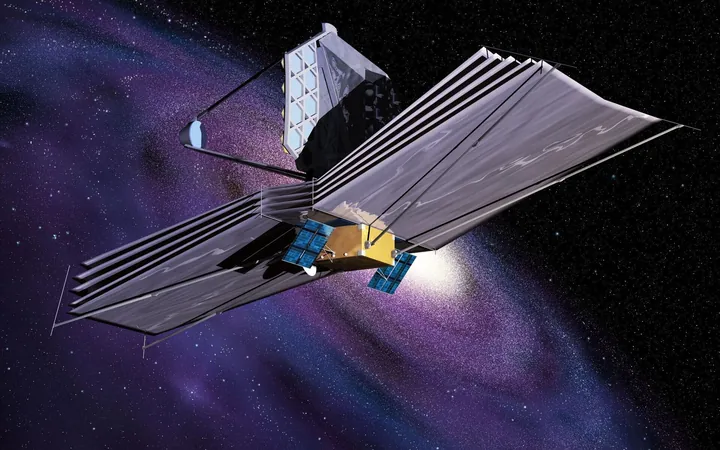
A Revolutionary Robot Could Construct a Giant Telescope in Space: Here’s How!
2024-11-07
Author: John Tan
Introduction
As humanity's quest to explore the cosmos continues, the need for advanced telescopes has never been greater. Historically, some of the most groundbreaking telescopes, like the Hubble Space Telescope and the James Webb Space Telescope, were launched into space through meticulous engineering and design. The Hubble was carried into orbit aboard the Space Shuttle Discovery, while the James Webb had to fit snugly inside an Ariane 5 rocket before deploying its intricate components as it journeyed to its designated home—a point in space known as the L2 Lagrange point.
The Challenge Ahead
Yet, as we move beyond the capabilities of these legacy systems, we face a challenge: how do we construct next-generation telescopes in space when they’re too large to launch in one piece? One innovative solution being proposed is to build telescopes directly in orbit using advanced robotic systems.
A Groundbreaking Study
A groundbreaking study published in the journal Acta Astronautica focuses on this very concept, introducing the idea of a walking robot to assist in the assembly of a massive space telescope. Titled "The New Era of Walking Manipulators in Space: Feasibility and Operational Assessment of Assembling a 25m Large Aperture Space Telescope in Orbit," this research, led by Manu Nair from the Lincoln Center for Autonomous Systems in the U.K., explores the mechanics and operational requirements of such a project.
Future of Astronomy
So, what does this mean for the future of astronomy? The authors argue that this approach is necessary to meet the rising demands for high-resolution observations of celestial phenomena and Earth. The current methods of launching telescopes into space can be exceedingly complicated and costly, particularly as the size of the mirrors required for high-resolution imaging continues to grow.
The Concept of LAST
To illustrate their point, the researchers envision a hypothetical telescope called LAST (Large Aperture Space Telescope)—a colossal 25-meter wide telescope designed to provide unprecedented views of the universe. LAST would be constructed using modular components called Primary Mirror Units (PMUs), with a total of 342 PMUs needed for its assembly. Interestingly, its primary mirror, made up of 18 segments, would include ports to facilitate integration and connections for power and data transmission.
Robotic Technologies
With current robotic technologies on the International Space Station—including the Canadarm and the European Robotic Arm—this concept is not as far-fetched as it might sound. However, those systems are limited by their need for human operators and their restricted walking capabilities. The proposed End-Over-End Walking Robot (E-Walker) is designed with advanced mobility features that could navigate complex environments and automate the construction process, reducing reliance on astronauts.
Supporting Spacecraft
To ensure successful assembly, the researchers propose two supporting spacecraft: a Base Spacecraft (BSC) to provide commands and monitoring for the E-Walker, and a Storage Spacecraft (SSC) for holding and organizing all the PMUs during assembly. Their research also outlines 11 different operational scenarios for how multiple E-Walkers could work together, optimizing tasks to expedite the telescope’s construction.
Broader Implications
The implications of this cutting-edge research extend far beyond just telescopes. With emerging technologies in robotics and artificial intelligence, the potential for building space infrastructures—including habitats, manufacturing facilities, and solar power stations—is immense. The research team notes that the ability to assemble complex systems in orbit will be crucial for the establishment of a sustainable and resilient space ecosystem in the coming decades.
Conclusion
In summary, while many hurdles remain in the way of deploying the E-Walker robot or similar technologies in space, the progress being made in robotics could pave the way for a new era of astronomical exploration. Soon, we may see giant telescopes constructed among the stars, unlocking secrets of the universe that have long eluded us. It’s a thrilling possibility that could change our understanding of the cosmos forever!


 Brasil (PT)
Brasil (PT)
 Canada (EN)
Canada (EN)
 Chile (ES)
Chile (ES)
 España (ES)
España (ES)
 France (FR)
France (FR)
 Hong Kong (EN)
Hong Kong (EN)
 Italia (IT)
Italia (IT)
 日本 (JA)
日本 (JA)
 Magyarország (HU)
Magyarország (HU)
 Norge (NO)
Norge (NO)
 Polska (PL)
Polska (PL)
 Schweiz (DE)
Schweiz (DE)
 Singapore (EN)
Singapore (EN)
 Sverige (SV)
Sverige (SV)
 Suomi (FI)
Suomi (FI)
 Türkiye (TR)
Türkiye (TR)